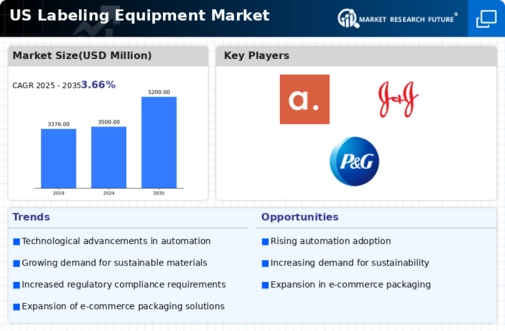Growth of the E-commerce Sector
The labeling equipment market is being propelled by the rapid growth of the e-commerce sector. As online shopping continues to gain traction, the need for efficient labeling solutions has become paramount. E-commerce businesses require labeling equipment that can handle high volumes of orders and provide accurate shipping labels. In 2025, the e-commerce sector is projected to grow by 15%, which will directly impact the labeling equipment market. Companies are increasingly adopting automated labeling systems to streamline their operations and enhance order fulfillment processes. This trend indicates a robust demand for labeling equipment that can support the logistics of e-commerce, thereby driving market growth.
Rising Demand for Customization
The labeling equipment market is witnessing a growing demand for customization in labeling solutions. As brands seek to differentiate themselves in a competitive landscape, personalized labels have become a key marketing tool. This trend is particularly evident in sectors such as cosmetics and beverages, where unique labeling can enhance brand identity. In 2025, the market for customized labeling solutions is anticipated to expand by 10%, driven by consumer preferences for tailored products. Companies are increasingly investing in flexible labeling equipment that can accommodate various label sizes, materials, and designs. This shift towards customization is likely to propel the labeling equipment market forward, as businesses adapt to changing consumer expectations.
Sustainability and Eco-friendly Practices
The labeling equipment market is increasingly influenced by sustainability and eco-friendly practices. As consumers become more environmentally conscious, companies are seeking labeling solutions that align with sustainable practices. This includes the use of recyclable materials and eco-friendly inks in labeling processes. In 2025, the market for sustainable labeling solutions is expected to grow by 7%, reflecting a shift towards environmentally responsible production methods. Businesses are investing in labeling equipment that can produce sustainable labels without compromising quality. This trend not only meets consumer demand but also helps companies enhance their brand image, thereby positively impacting the labeling equipment market.
Regulatory Compliance and Safety Standards
The labeling equipment market is significantly influenced by stringent regulatory compliance and safety standards. In the US, industries such as food and pharmaceuticals are subject to rigorous labeling requirements to ensure consumer safety and product traceability. Compliance with regulations such as the FDA's labeling guidelines necessitates the use of advanced labeling technologies that can produce accurate and compliant labels. This has led to an increased demand for labeling equipment that meets these standards. As companies strive to avoid penalties and ensure product safety, the labeling equipment market is expected to see a steady growth rate of around 6% in the coming years, as businesses invest in compliant labeling solutions.
Technological Advancements in Labeling Equipment
The labeling equipment market is experiencing a surge due to rapid technological advancements. Innovations such as high-speed printing, digital labeling, and automated application systems are enhancing efficiency and accuracy. These technologies enable manufacturers to produce labels at a faster rate, reducing operational costs. In 2025, the market is projected to grow by approximately 8% annually, driven by the demand for more sophisticated labeling solutions. Furthermore, the integration of IoT in labeling equipment allows for real-time monitoring and data collection, which is becoming increasingly vital for businesses aiming to optimize their supply chains. As companies seek to improve their production processes, is expected to benefit significantly from these advancements..














Leave a Comment